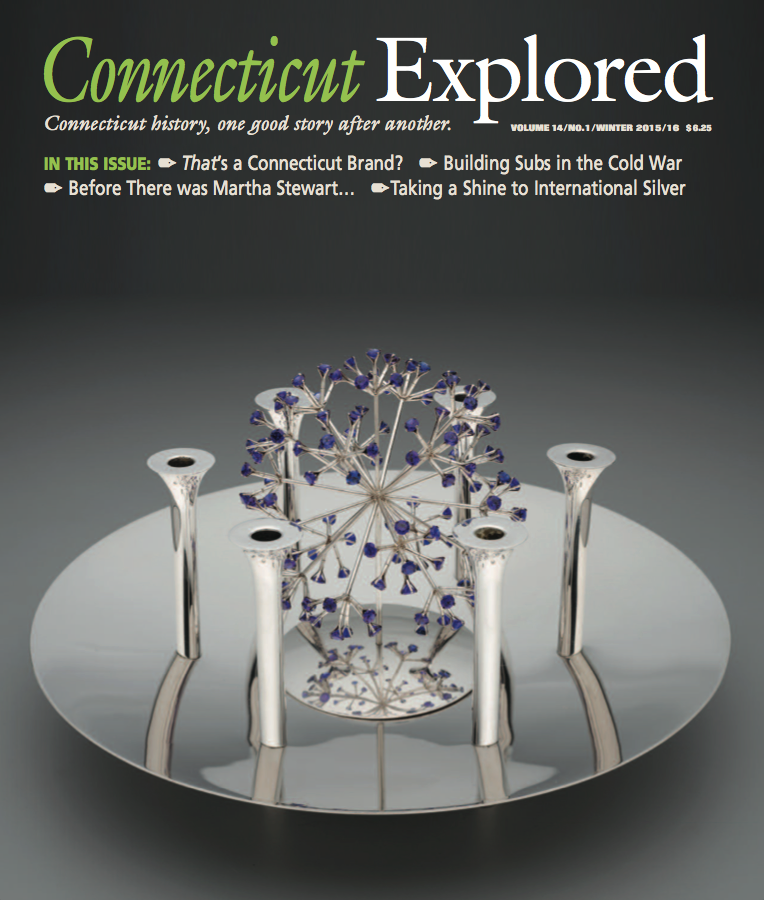 By Elizabeth Normen and David Corrigan
By Elizabeth Normen and David Corrigan
(c) CT Explored Inc., WINTER 2015/16
Subscribe/Buy the Issue!
In this photo essay we celebrate six iconic brands that Connecticut can claim as having fostered—some of them so ubiquitous you never stop to think where they came from, and many with memorable advertising tag lines. All of these products are still in production, though only two companies (Casco and E.E. Dickinson Company) remain based in Connecticut. Bon Ami and Fuller Brush currently sell product lines based on their original 1886 and 1906 products, respectively, finding a new market for the “original.” And where would IKEA be without the Allen wrench—a Connecticut-perfected product?
Several of these products have been featured in longer articles in previous issues, from which we’ve derived excerpts for this photo essay. We’ve noted which ones they are so readers can go back and read the full and fascinating stories.
All images from the Museum of Connecticut History
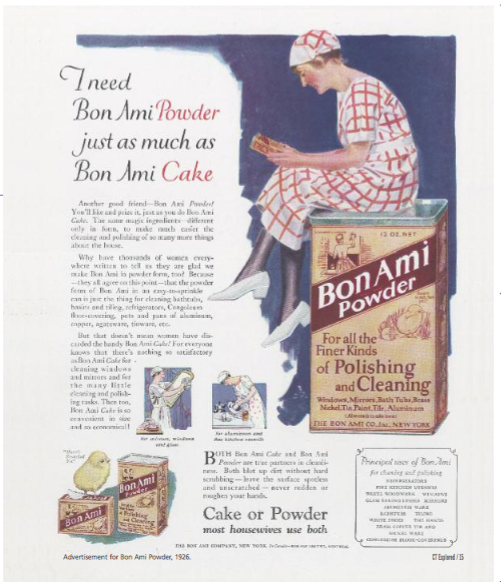 Hasn’t Scratched Yet!
Hasn’t Scratched Yet!
From John A. Pawloski, Sr., “The Industrial Might of Connecticut Pegmatite,” Connecticut Explored, Summer 2010
Ad for Bon Ami Powder, 1926
Feldspar mining peaked in Connecticut in the early 1900s; in 1908 Connecticut was the leading producer of this mineral in the United States. Perhaps the most famous feldspar-based product is Bon Ami cleanser, which features the relatively soft mineral as a mild abrasive. In 1885 mineral-soap pioneer J.T. Robertson opened his first factory, in Glastonbury. He founded the J.T. Robertson Company to produce his soap and moved to Manchester in 1891. The Child & Child Company of New York City, which served as Roberston’s selling agent, obtained a five-year option to purchase the manufacturing rights in 1893, and the Bon Ami Company was formed. Initially all the feldspar the company used came from Connecticut; later, much of the feldspar was imported from New Hampshire and Canada because it was cheaper. The Manchester plant continued to manufacture Bon Ami until the late 1950s. Today Bon Ami is located in Kansas City, Missouri.
“Hasn’t Scratched Yet!”® derives, according to bonami.com, from the fact that “newly hatched chicks do not scratch for food because they are still living off the nutrients of the yolk.” That memorable tagline dates to 1886.
Read more: “The Industrial Might of Connecticut Pegmatite,” Connecticut Explored, Summer 2010
Dickinson’s Witch Hazel 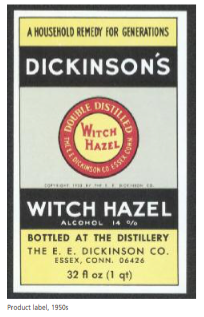
From Mary M. Donohue, “Witch What? Connecticut’s Wonder Shrub,” Connecticut Explored, Spring 2007
Product label, 1950s
Distilled from the bark and twigs of the witch hazel plant or Hamamelis virginiana, witch hazel has been used for hundreds of years to treat everything from bug bites to hemorrhoids. Originally an herbal remedy brewed by New England’s Native Americans, the liquid’s never since gone out of production. Witch hazel’s principal producers for the past century, the E.E. Dickinson Company and its offshoots, have been located in Essex and currently East Hampton, Connecticut since Dickinson’s founding in the late 19th century.
Read More: “Witch What? Connecticut’s Wonder Shrub,” Connecticut Explored, Spring 2007
The Fuller Man Brings This… and more!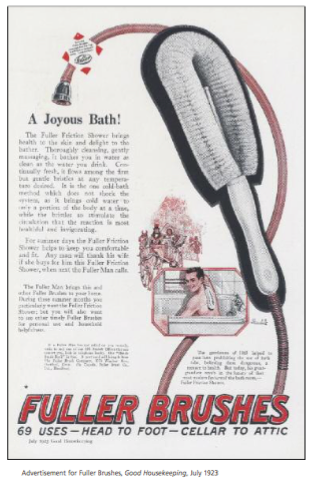
From Vincent Michael Valvo, “The Fuller Brush Company,” Connecticut Explored, Fall 2007
Ad for Fuller Brushes, Good Housekeeping, July 1923
For the better part of the 20th century, the Fuller Brush Man (or Fuller Man, as he’s identified in this ad) was a ubiquitous American icon, seemingly getting his foot in the door of every household in America. Founded in 1906 in Boston, the Fuller Brush Company rose to prominence in Hartford (and later East Hartford) after moving there in 1909. Before vacuum cleaners, brushes were the workhorses of housework. But most brushes were also made by hand, often poorly, and their ill-conceived designs prevented their doing the work for which they were intended. Fuller created a brush-making machine that could produce a product with more bristles and in various contours designed for specific tasks. In his first year he made the remarkable sum of $8,500, proof that there was a market for his products. That’s when Fuller moved to Hartford—a city he had visited on his sales trips—to open full-scale manufacturing operations. Today, Fuller is located in Great Bend, Kansas.
Read more: “The Fuller Brush Company,” Connecticut Explored, Fall 2007
The Original Lighter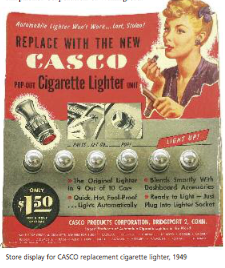
By Dave Corrigan
Store display for CASCO replacement cigarette lighter, 1949
Until the 1990s, dashboard cigarette lighters were standard equipment on virtually all American-made automobiles. The major producer of these lighters was the Connecticut Automotive Specialty Company, known as CASCO Products Corp., founded by Joseph H. Cone in Bridgeport in 1921. In 1928 the company developed a “cord and reel”-type automotive cigarette lighter, in which the lighter was connected to a power source by a cord wound around a spring drum. In 1958 CASCO manufactured an automatic lighter that, when pressed into its dashboard socket, heated the coil hot enough to light a cigarette. The company claimed ads and other promotional materials that this became “The Original Lighter in 9 out of 10 Cars.” With the decline in smoking and the rise of portable electronic devices, CASCO became a leading manufacturer of dashboard-mounted USB connectivity and charging ports and power USB sockets, adapting the earlier technology to meet 21st-century needs. The company has undergone several changes in name and ownership and, most recently, the CASCO Automotive Group, still located in Bridgeport, was acquired by the Amphenol Corporation of Wallingford.
Look for the Corner Triangles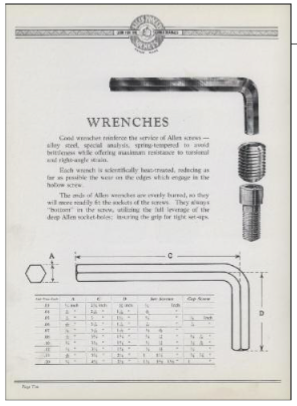
By Dave Corrigan
Page from a sales brochure for Allen Manufacturing Co. products, c. 1935
During his many years in manufacturing, William G. Allen (1861-1928), a Rockville native, had observed a major safety issue, especially in machine shops, where the heads of hex-headed bolts, traditionally used to hold the various parts of machine tools together, protruded above the surface of the parts into which they were installed. Workers would often catch their clothing, bump their heads, or otherwise be injured by the protruding bolts. Allen solved this problem by designing a screw with a six-sided socket recessed into the head, so that it was flush with the surrounding surface when fully tightened. In 1910 Allen received U.S. patent #960,244 for the “Manufacture of Screws,” covering the making of what he termed “flush head set screws.” According to Allen, this socket was “designed to receive a strong key or crank end for turning.” Today, Allen is not remembered for his set screws, but his name lives on in his “key or crank end” used for turning them, now known as the “Allen wrench” or “key wrench,” the generic name applied to any six-sided hex wrench. And while Hartford’s Allen Manufacturing Co., established by the inventor, is long gone, the Apex Tool Group of Sparks, Maryland currently manufactures a wide variety of hex wrenches using the “Allen” name, the rights to which it owns.
Sometimes You Feel Like A Nut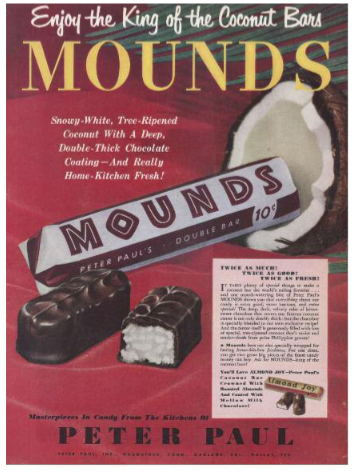
From Greg Pugliese, “Peter Paul’s Path to Sweet Success,” Connecticut Explored, Spring 2010
Ad for Mounds candy bars, 1950s
Everyone remembers the famous campaign mounted by candy giant Peter Paul, Inc., “Sometimes you feel like a nut, sometimes you don’t,” which referred to Peter Paul, Inc.’s two most popular candies, Mounds and Almond Joy. By the 1980s, the company was a giant in the industry, with annual net sales topping $70 million. It had come a long way from its humble beginnings as a small-town confectionery shop in Naugatuck, Connecticut that was established in 1895. In April 2007, the Pennsylvania-based Hershey Company, which had acquired the operation in 1988, announced it would close the Naugatuck plant.
Read more: “Peter Paul’s Path to Sweet Success,” Connecticut Explored, Spring 2010
Explore!
Read more about the state’s manufacturing history in “We Made It!,” our 5th-anniversary issue (Fall 2007), “Made in Connecticut” (Spring 2005), and two issues from the labor perspective: “All in a Day’s Work,” Spring 2004, and “Connecticut at Work,” Winter 2013/2014. The Winter 2011/2012 “Connecticans Abroad” issue has a wonderful photo essay showing efforts beginning in the mid-19th century to sell Connecticut-made products across the globe.
